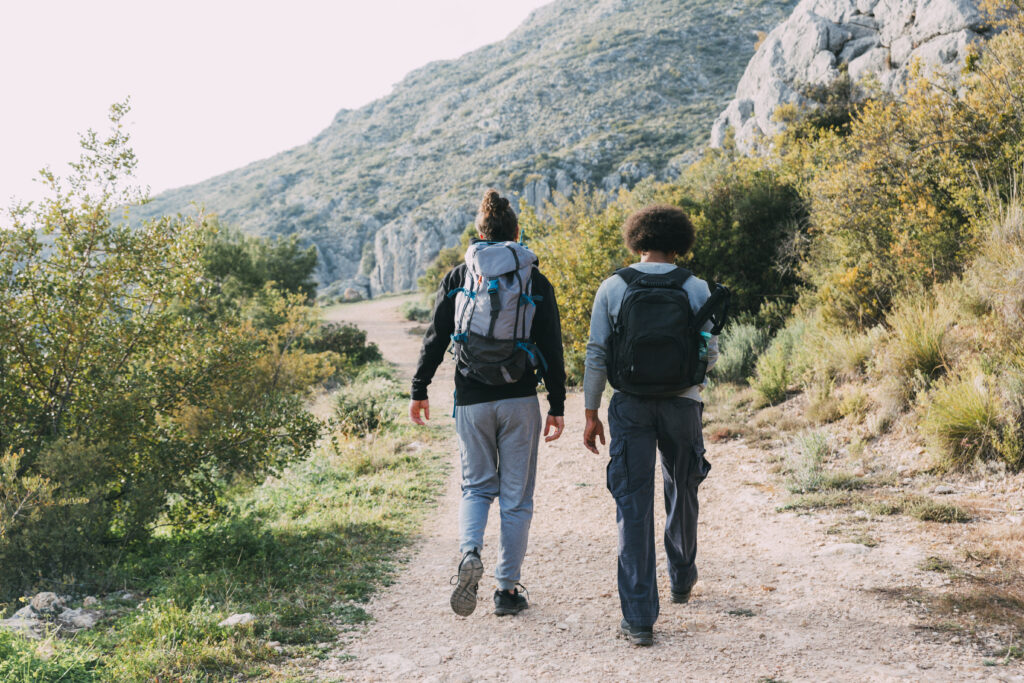Introduction
Two of such exercises are hiking vs walking which people use for exercise, pleasure or to have an interface with nature. As much as they might appear to be closely related, these activities bear specific features that define them, their advantages, and disadvantages. Hiking vs Walking are concepts that need to be distinguished so that one can be able to choose what is best in terms of fitness levels, goals, and preference.
Here, in this article, the specific topics that would be addressed comprises of ascending / descending, the tasks involved; terrains, the equipment needed in Hiking vs Walking; and health outcomes. At the end of the set exercise, you shall as by now, know which of the two activities fits your lifestyle and how you can engage in both for the balanced activities in fitness and health.
What is Hiking vs Walking
Hiking is a form of walking which takes place on trails, paths or tracks and is often on natural landscapes or terrains such as forests, mountains or hills. Moving by it is usually tiring compared to walking, and it has some fitness and preparatory demands. Hikes can therefore be done for a short distance and relatively flat land to a long distance over mountainous terrains which may need compass and other tools.
Types of Hiking vs Walking:
• Day Hiking: Explores a track with some few hours up to a whole day without the need for extensive camping.
• Backpacking: Tracks with camping involved either for multiple days or even weeks, where all the materials for the trip have to be carried in a backpack.
• Thru-Hiking: Usually entails through-hiking a trail from one end to the other – for example, the Appalachian Trail may take weeks or even months to complete.
What is Walking?
The matter is that walking is an easy and unprescription type of physical activity which can be conducted both on city streets and parks. One of the easiest and most convenient types of a physical exercise that may be practiced by individuals of various ages and physical fitness . There are various ways in which walking could be done, right from the casual stroll, fast paced walks and the pleasant leisurely walk and are easily adaptable to the busy schedules.
Types of Walking:
• Casual Walking: Concerns a slow speed, which may be to enjoy an activity or to travel by means of a certain lure.
• Power Walking: Including a higher tempo that moves and activates more of the muscles with moderate intensity heart exercises.
• Nordic Walking: It involves poling and hence utilizing poles to work on the upper frame of the body in quite a resemblance to cross-country skiing.
Physical Demands: Hiking vs Walking is another term that can be compared to walking for it also involves the use of ones feet to move from one point to another but through rough terrains or up and down hills.
There is a considerable disparity in terms of physical endeavours that are entailed in Hiking vs Walking. Erhel has it that hiking calls for more energy, endurance and strength because of the more rugged and uneven ground. Walking on the other hand is relatively less rigorous and can be performed for longer durations with out Fatigue.

Hiking vs Walking:
• Elevation Gain: Unlike walking, hiking entails incline and decline slopes, this makes the cardio vascular and muscular demands higher.
• Varied Terrain: Terrain in trails is rugged and can be made up of rocks molten earth or any other surface which poses strength and stability that tests the balance and coordination of any athlete.
• Endurance: More involved hikes require more endurance and one has to be capable of toting a backpack with provisions.
Hiking vs Walking:
• Flat Terrain: It is usually performed on flat terrains and trails, for instance, a sidewalk or a park hence does not exert much pressure on some of the body parts.
• Pace Control: The more demanding workouts are easy to manage by the walker since the walker can control the rate it offers out.
• Low Impact: The penthouse of this form of exercise is that it has minimal impact on the joints and muscles therefore allowing one to walk even when injured.
Environmental Settings: Hiking vs Walking
The places that Hiking vs Walking occur also differ with certain factors that affect the interaction between the person and the nature.
Hiking vs Walking:
• Natural Settings: The trails providing a logistical path for Hiking vs Walking are commonly found in wilderness or semi wilderness areas thus offers a chance of an encounter with nature.
• Scenic Views: This can be in the form of a view point, a waterfall or some form of rock formation that is unique to that area.
• Wildlife Encounters: Wildlife observation is a common norm when in natural terrains when hiking as one may come across birds, more so the larger mammals.
Hiking vs Walking:
• Urban and Suburban Areas: It is usually conducted in cities, towns or suburban areas thereby proving to be easily accessible.
• Green Spaces: Rows, gardens, and water frontages offer aesthetic areas for walking though considerably man-made and less natural than walking paths.
• Social Interaction: The nature of safe walking is such that it happens in areas that are occupied by people; therefore, people will always be encountered either while Hiking vs Walking with people or when one is meeting other people they know.

Equipment and Preparation: Hiking vs Walking
The equipment and the accessories that have been left for Hiking vs Walking show that these two activities have different qualities.
Hiking vs Walking:
• Footwear: It is very important to wear as comfortable and solid shoes or boots during the hike because as you may notice there are a lot of rough and steep surfaces.
• Clothing: Warm clothes are welcome for this type of climate and additionally, it helps to have several layers of clothing as the weather is changeable and, moisture wicking fabrics are also important to keep dry.
• Backpack: A backpack is required for storing water, food, first-aid kit among other things that may be required during the hike especially if the hike is long.
• Navigation Tools: For that you often have to determine where you are going when you are traveling an unknown track and usually here you will require maps, compass or GPS.
• Safety Gear: That varying chain will require extra protection equipment like bear repellent, whistle, or a headlamp according to the country of the hunt.
Hiking vs Walking:
• Footwear: Just normal walking shoes that will be comfortable and with good support for your arches are a good bet for most walking endeavors.
• Clothing: Informal and loose-fitting comfortable attire is allowed with acceptions for climatic conditions, which might require a jacket or hat.
• Hydration: For short distance hikes, you might only require a small water bottle hence carrying a hydration pack would be unnecessary for long distance trails.
• Minimal Gear: Walking in general does not need many materials and as such, there is no much preparation needed to start with.
Health Benefits: Hiking vs Walking
Hiking vs Walking are activities that have numerous benefits to health though the differences may be in the intensity as well as the kind of benefits that are associated with the two.

Hiking vs Walking:
• Cardiovascular Fitness: The high intensity of walking on elevated terrains through hiking is very effective to enhance the health of the hearts.
• Muscle Strength: Hiking is an activity that strengthens various muscle group, lower and the upper extremities, especially the leg muscles, abdominal muscles as well as the muscles in the back and arms when the hiker is toting a backpack.
• Mental Health: Adverse effects of Hiking vs Walking which are stress, anxiety, and depression are totally eliminated by the natural environment hence improving the mental health of an individual.
• Calorie Burn: Hiking involves more vigorous movements than walking and this is made even more vigorous by inclined terrains thus a good tool in weight loss.
Hiking vs Walking:
• Joint Health: Thus, it is important to start walking because it is non-impact exercise and it will reduce the chances of arthritis in our joints.
• Weight Management: One way of setting up such a slow walking regime is as follows: Hiking vs Walking can aid in the process of keeping off extra weight in conjunction with balanced dieting.
• Bone Density: As far as the physical benefits of walking are concerned, it enhances the bone density and makes a reparable for osteoporosis for those who are normally in their fifties.
• Mood Enhancement: On the subjects’ part, walking, and particularly walking outside the house, always has an uplifting impact on everyone’s mood and thought process because of the endorphin rush.
Accessibility and Inclusivity: Hiking vs Walking
The possibilities of Hiking vs Walking also vary in some aspects, thereby making one or the other preferred activity for those interested.
Hiking vs Walking:
• Skill Level: Cross country travel tends to be more challenging in terms of skill level for skills such as map reading, stamina, and even skills for camping or any other forms of spending nights out in the wild especially when it comes to steep trails.
• Physical Fitness: As said before, there are easy trails as well as the difficult ones and though the latter cannot be ruled out those trails are challenging for those who are not very physically fit.
• Accessibility: Since they may be reached via primitive roads, some trails may lie close to areas that are inaccessible by persons with disabilities or without private cars to access trailheads.
Hiking vs Walking:
• Ease of Access: It can be performed nearly every where and on any surface starting from roads of the big city to the shopping malls, that is why it is very versatile.
• Inclusivity: As for the intensity, Hiking vs Walking can be done by almost every age and requires no much effort, and it can be done by adapted individuals with physical disabilities.
• Community Engagement: It was found out that the formation of regular meeting walking groups and events can likely create societal support for physical programs among communities of walkers.
Variation of Hiking vs Walking as the Activities
Thus, adjusting between Hiking vs Walking can provide a great way of the balanced fitness regime since both activities are possible to combine.
Weekend Hiking vs Walking:
• Adventure and Exploration: It is advisable to use your weekends or days off to go and hike or try out new trails, this will help you challenge your body and your mind.
• Recovery and Rest: Rest periods should be spent in between hikes with muscles allowed time for recovery and to relax.
Daily Hiking vs Walking:
• Consistency: Try to walk as much as possible – not only as transport, but also exercise or even a way to calm down.
• Habit Formation: Ensure that Hiking vs Walking is incorporated into your lifestyle through scheduling time when it will be done, as for example after meals or during other breaks.
Conclusion
Climbing and strolling are very much alike but at the same time they are different activities that give different experience and bring different effects. Hiking vs Walking is a more stressing way of interacting with nature which requires the use of the bodies in its strenuous form. Hiking vs Walking is on the other hand a more flexible low intervention activity that does not require much effort and time from the individuals and can be incorporated in their day-to-day life activities.
By stemming the knowledge as to when does Hiking vs Walking become different from walking you can easily determine what options suit your lifestyle of intentions the best. For those who love to engage in a strenuous activity such as hiking or those who require a normal Hiking vs Walking exercise, both are beneficial to our health, mental health, and our interaction with the environment. Accept Hiking vs Walking as two camarous activities that enhance your life boosting your chances of exploring, exercising, and having fun.

Pingback: The Complete Guide to Hiking Pants: Cozy and practical